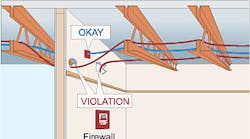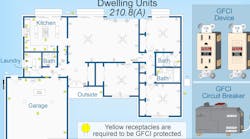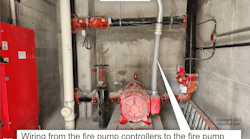Fire Alarm Signaling Systems
A fire alarm signaling system must not be an early casualty of a fire
Interest in emergency systems rose sharply after 9/11 and remains high. Building owners no longer install fire alarm signaling systems just to satisfy their insurance company. Today, their motivation is keeping employees safe, by including new installations, retrofits, upgrades, testing, and maintenance. The requirements of Art. 760 cover the installation of wiring and equipment for fire alarm systems, including all the circuits that control and power the fire alarm system. NFPA 72 National Fire Alarm Code provides other fire alarm system requirements.
Fire alarm systems include fire detection and alarm notification, voice communications, guard's tour, and sprinkler supervision. The fire alarm system might also control or power other systems, including elevator capture and shutdown, door release, smoke doors and damper control, fire doors and damper control, and fan shutdown. Building control circuits associated with the fire alarm system, such as elevator capture and fan shutdown, must comply with the requirements of Art. 725. The rules of Art. 760 apply only where the fire alarm system directly powers and controls these circuits.
Special installation requirements apply to:
-
Fire alarm circuits in ducts, plenums, and other air-handling spaces (300.22).
-
Fire alarm circuits in hazardous, or classified, locations (Art. 500 to 516).
-
Building control circuits associated with the fire alarm system, but not powered by it or controlled by it (Art. 725).
-
Optical fiber cables used in fire alarm circuits (Art. 770).
General installation requirements.
Part I gives general requirements, and you can find definitions specific to fire alarm systems in 760.2. For example, a nonpower-limited fire alarm (NPLFA) circuit is a circuit that can't operate at more than 600V. Neither power nor current for such circuits is limited. An NPLFA circuit is similar to a Class 1 circuit. The main difference is an NPLFA circuit is powered and controlled by the fire alarm system — frequently at 120V. You can't supply these circuits, or those of power limited fire alarm (PLFA) circuits, through GFCIs — except as noted in the FPNs that refer to 210.8(A)(5).
You must locate cables so they don't prevent the removal of ceiling panels for access to electrical equipment (760.5) (Fig. 2 above). In addition, you must install equipment and cabling in a neat and workmanlike manner, and support them as required in 760.6. If you install cables exposed on the surface of ceilings and sidewalls, support them by the structural components of the building in a manner that prevents damage from normal use. You can secure the cables to structural components by straps, staples, hangers, or similar fittings designed and installed so as not to damage the cable.
If you install cables next to framing members, the Code requires you to protect them against physical damage from penetration by screws or nails with 1.25-in. separation from the face of the framing member or by a suitable metal plate per 300.4(D).
Where twisted-pair, power-limited fire alarm circuit conductors extend beyond a building, install them according to the requirements of Art. 800 or use a Chapter 3 wiring method (760.7).
System grounding isn't required for fire alarm circuits that operate at 50V or less (760.9). Fire alarm circuits that operate at more than 50V must follow the grounding and bonding requirements in 250.30.
Identify fire alarm circuits at all terminal and junction locations in a manner that will prevent unintentional interference with the fire alarm circuits during testing and servicing (760.10) (Fig. 3).
After giving the general requirements in Part I, Art. 760 gives the requirements for NPLFA circuits in Part II and PLFA circuits in Part III. Part II is about half the size of Part III. Let's look at Part II first.
NPLFA circuits.
The main thing to remember about NPLFA circuits is that their power source can't exceed 600V, nominal. They also differ from PLFA circuits in another way: overcurrent protection devices (OCPDs). OCPDs must not exceed 7A for 18 AWG or 10A for 16 AWG conductors. You must locate the OCPDs at the point where the conductor receives its supply, unless your system meets one of three exceptions noted in 760.24.
Class 1 and NPLFA conductors can be in the same cable, enclosure, or raceway without regard to whether individual circuits are AC or DC, provided all the conductors are insulated for the maximum voltage of any conductor in the enclosure or raceway (720.6). Power supply and NPLFA conductors can be in the same cable, enclosure, or raceway only where connected to the same equipment.
You can use only copper conductors in fire alarm systems. Insulation must be suitable for 600V (720.27). Other conductor limitations apply.
If you have only NPLFA and Class 1 conductors in a raceway, fill it according to 300.17 (760.28). You can use the derating factors of 310.15(B)(2)(a) if the conductors carry a continuous load in excess of 10% of the ampacity of each conductor. If you mix power supply and NPLFA conductors in a raceway per 760.26, determine the wire fill per 300.17. You must derate these mixed conductors if the conditions in 760.28(B) apply. If you install conductors in cable trays, apply 392.9 through 392.11.
You can use multi-conductor NPLFA cables if the cables and installation methods meet a long list of requirements (760.30), including the following:
-
The circuits must be 150V or less.
-
You must provide support at intervals of not more than 18 in. if the cables are within 7 ft of the floor.
-
You can't install Types NPLFP, NPLFR, or NPLF in plenums or ducts unless in a metal raceway complying with 300.22(B).
-
You must use a specific cable type for certain applications. For example, you must use Type NPLFR for vertical runs that penetrate more than one floor.
-
The cables must be listed as circuit integrity (CI) cable.
PLFA circuits.
PLFA circuits (load side) don't have OCPDs, but their power sources (supply side) do. You must protect transformers or other devices supplied by power-supply conductors by an OCPD rated not greater than 20A. A PLFA power source must be one of the following:
-
A listed PLFA or Class 3 transformer.
-
A listed PLFA or Class 3 power supply.
-
Other power-limited fire alarm equipment listed for use.
While you don't need to mark NPLFA circuits as such, 760.42 requires you to label PLFA circuits with durable and plainly visible markings on the equipment to indicate each circuit that's PLFA.
For PLFA circuits, you can use the same wiring methods already discussed for NPLFA circuits (760.52) (Fig. 4 above). As you might expect, exceptions apply. For example, the derating factors given in 310.15(B)(2)(a) don't apply to PLFA conductors.
If you need to install PLFA circuits inside the same raceway or cable with power or Class 1 circuits, you can reclassify PLFA circuits. To do so, remove the PLFA marking on the equipment, provide OCPDs per 760.23, and ensure the conductors have insulation suitable for 600V. You may not install PLFA circuits reclassified as NPLFA circuits with other PLFA circuits not reclassified as NPLFA.
Separation is an important concept for PLFA circuits. Per 760.55, you can't place PLFA conductors in any enclosure, raceway, or cable with conductors of electric light, power, Class 1 NPLFA circuits, or medium power network-powered broadband communications cables (non-power-limited energy circuits). You can mix PLFA conductors with non-power-limited energy conductors if the non-power-limited energy circuit conductors are introduced solely to connect to the equipment and comply with either of the following two points:
-
You maintain at least .25 in. of separation from the PLFA conductors.
-
The non-power-limited energy circuit conductors operate at 150V or less to ground and the PLFA conductors are installed as NPLFA circuits per 760.25 (760.52 Exception No. 3).
Art. 760 lays out rules for ensuring that fire alarm system wiring lasts long enough for occupants to escape a fire. You need to understand the general requirements in Part I, no matter what kind of system you install. If the system is power-limited, follow the requirements of Part II. If the system isn't power-limited, follow the more detailed requirements of Part III. And remember, your work with fire alarm systems does more than satisfy an insurance company requirement.
Still confused by the Code? For additional information on Code-related topics please visit www.mikeholt.com or send an e-mail directly to the author at [email protected].








